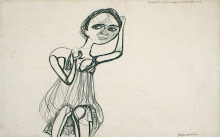from How Soccer Explains the World, Franklin Foer:
The biggest soccer stadium in Tehran, in the world for that matter, is the 120,000-seat Azadi. Even though its name translates as “freedom”, it represents something close to the opposite. Ever since the Islamic revolution of 1979, females have been forbidden to watch soccer in the Azadi. This prohibition isn’t exclusive to the venue or even to Iran. It applies in broad swaths of the Muslim world . . . But the fundamental fact of Iran is that it is not Saudi Arabia. With so many people flowing through the Azadi’s turnstiles, it’s impossible to ensure conformity with the finer points of Islamic law. Some of the men are clean shaven and dressed in suspiciously baggy clothes. Under closer inspection, it would become clear that these men aren’t even really men. Risking severe punishment, Tehran’s women have been unable to let go of the Azadi.
This corps of aggrieved, soccer-starved women, it is reported, included the daughters of important clerics . . . In 1987, the country’s spiritual and political dictator, Ayatollah Ruhollah Khomeini, issued a new fatwa that revised the regime’s absolute prohibition of female fandom. Speaking through his long white beard, he decreed that women could watch soccer on television, which would carry games for he first time in the Islamic era, but still disallowed trips to the testosterone-laden stadium.
But even the mullah’s rare stroke of Solomonic reasoning couldn’t placate the deep desires of Iranian women. Like all good fans, they understood that technology is a poor substitute for the real, flesh-an-blood experience. In hindsight, it was inevitable that women would demand to be let back in. Still, such a bold demand requires great courage and pretext. The heroics of the national team in November 1997 gave the women of Iran both. Iran’s campaign to qualify for the World Cup turned on a single playoff game against Australia, played in Melbourne . . . [they won].
Some women threw off the hijab and partied without any of the mandated head coverings. When the basiji, members of the religious paramilitary militia, arrived to shut down the demonstrations, they were persuaded to join the roistering themselves. . . . when the team finally returned three days later, the government held the celebration in the Azadi. The heroes arrived in the stadium via helicopters, as if Silvio Berlusconi had planned the event. But the real spectacle wasn’t inside the stadium. Thousands of women defied the state’s pleas and gathered on the other side of the Azadi’s gates, in the 27-degree chill. As the anthropologist Christian Bromberger has reported, when the police refused to admit these women to the stadium, they began shouting “Aren’t we a part of this nation? We want to celebrate too. We aren’t ants.” Fearing the horde, the police let three thousand women into special seating.
But what about the two thousand women on the other side of the turnstile who hadn’t wormed their way into the Azadi? Determined to get their own piece of the celebration, they broke through the police gates and muscled their way into the stadium. Intent on avoiding a major fracas that could steer the raw emotions of the day in a dangerous direction, the police had no choice but to overlook their entry and concede defeat.
eels- novocaine for the soul
skip to main |
skip to sidebar
"Music is a mediator between spiritual and sensual life."
Blog Archive
-
▼
2006
(255)
-
▼
August
(28)
- No title
- Bob Dylan / Modern Times (a stream of the whole ne...
- self help reading + music
- blindly here to stand but still not sleeping
- The Judge—at most, under extreme duress, he offers...
- I’m just trying to cheer you up, she says.Does it ...
- ricky lee jones - someone to watch over me
- cannibal buffet, 8.06.........i.e. Wisconsin.Refug...
- sneaker pimps - low place like home
- “Metrophobia”Sophophobia - fear of learningOptopho...
- He collects things. Music. Alphabetizing, then by ...
- to our joys a clog .isreal kamakawiwo - somewhere ...
- 'a mistake for me today' - jonathon richman (salo...
- live tonight in Buffalohe is going like Cash, more...
- ambulance ltd - fearless [syd barrett cover]
- .ane brun - this voice
- tone: better
- theorizing education, v. 1
- Xwilco- kamera.....not titled,7.2006......Chad Van...
- .john lennon - beautiful boy
- wanted: human beings
- fiona apple - extraordinary machine (video live)
- linger is a lovely word
- self help reading + music
- fear is the heart of most things
- Faure- Requiem- Celilia Bartoni
- from How Soccer Explains the World, Franklin Foer:...
- self help reading + music
-
▼
August
(28)
